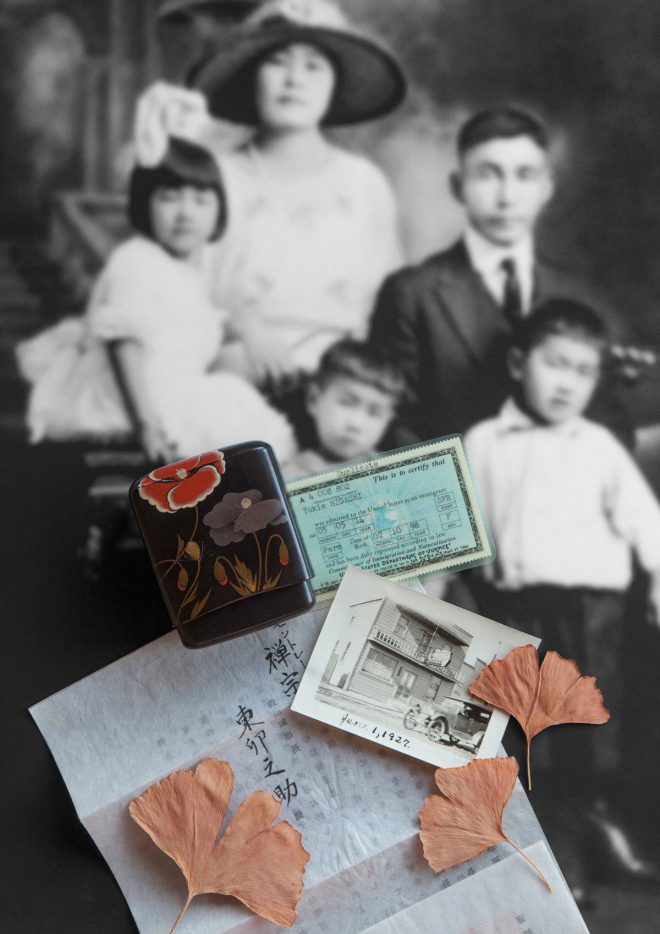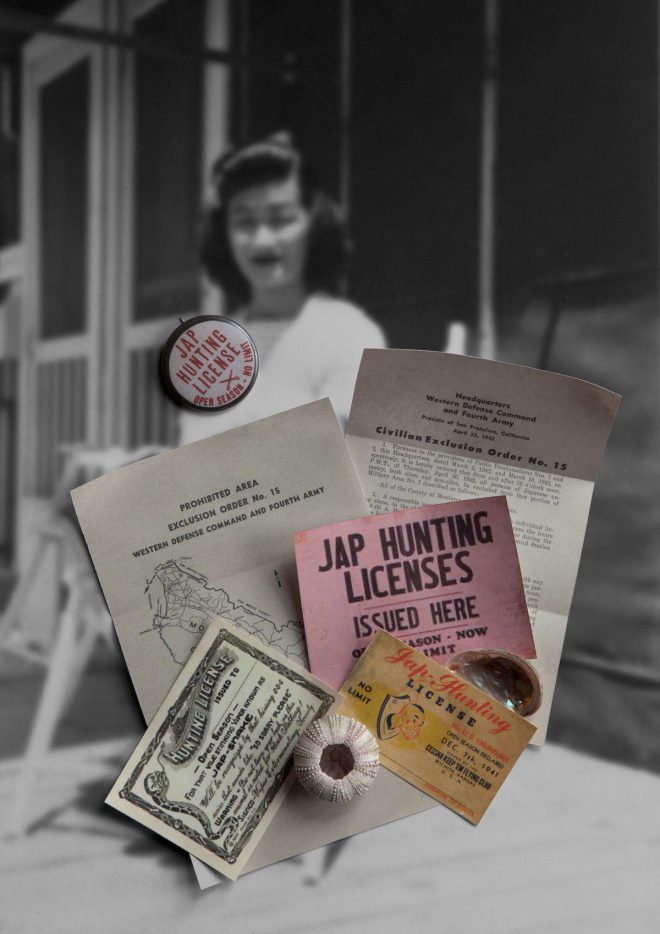Speaking Up: Jerry Takigawa at the New Orleans Photo Alliance
Myles Poydras looks at Jerry Takigawa’s staged still-life photographs, which reexamine the painful legacy of Japanese internment in the United States.

Jerry Takigawa, Immigrant’s Story, 2017. Pigment print. Courtesy the artist.
Jerry Takigawa’s “Balancing Cultures” at the New Orleans Photo Alliance contains a series of photographs that show the complex discord between a proud family lineage and a scornful national history. Takigawa tells a story about the Japanese-American internment during World War II by overlapping personal family portraits with scraps of documents and other artifacts alluding to this legacy of racism and cruelty.
One work, Looking Like the Enemy, 2017, features a black-and-white photograph of a Japanese woman—one of Takigawa’s ancestors—as an out-of-focus background to the larger composition, which also includes, layered over the portrait, “hunting licenses”—grotesque satirical propaganda sanctioning anti-Japanese violence—and exclusion orders demanding the removal of people of Japanese descent from areas along the West Coast. The papers and objects sit over the otherwise banal portrait, revealing a clash of national identities. Takigawa repurposes his family’s photos in order to expose a paradox of being Japanese-American; that is, for many who faced internment, being born in America, but being condemned and punished for acts of a foreign government.
In Immigrant’s Story, 2017, Takigawa uses a portrait of two young boys, a young girl, and, presumably, their two parents, dressed and aligned for the portrait in dress clothes typical of the early 1900s. Despite their adaptation to American culture, Japanese immigrants to America were often made victims of prejudice and racism due to xenophobic sentiments. Early laws restricted naturalized citizenship in the United States to “free white persons,” and the Immigration Act of 1924 prevented almost any person of Japanese descent from coming to America for fear that their presence would become too widespread.

Jerry Takigawa, Looking Like the Enemy, 2017. Pigment print. Courtesy the artist.
When Japan bombed Pearl Harbor at the end of 1941, the American government used the attack to justify reasons to act on its biases. Without posing a threat to other Americans’ safety or having any ties to the attacks, many Japanese-Americans had their land taken from them and were forced to either relocate from their homes or were imprisoned in overcrowded internment camps.
Addressing this history, Citizen’s Indefinite Leave, 2017, follows the same formula as Takigawa’s other photographs, using a quiet family portrait—this time of a couple—matching the personal integrity of its subjects with scores of indignity brought on by the events of their imprisonment and relocation. The relocation documents layered on top cast a shadow over their romance. Another photo, Staying Silent, 2017, shows lettered tiles spelling out the word “gaman” along with a scrap of paper with the same word in Japanese characters. The word means patience or perseverance—the qualities to endure, which many of the victims have done in silence. But from behind this silence, in each of Takigawa’s photos, a bitterness surfaces from the clash of an ideal and a truth: the ideal being the American Dream, sought after by immigrants of many backgrounds, the truth being the shameful reality of Japanese-American internment.
Takigawa’s works also bring to mind current debates over immigration between the United States and Mexico, which have recently exposed the U.S. government’s policy of separating children from their families after being detained at the border. While politicians often point to economic reasons for denying Latin Americans entrance into the United States, one can look back to the internment of Japanese-Americans to better understand the racist motives driving these present-day acts.
Editor's Note
Jerry Takigawa’s “Balancing Cultures” is on view through August 12, 2018, at the New Orleans Photo Alliance (1111 St. Mary Street). Contact the Photo Alliance directly to make an appointment to see the show.



